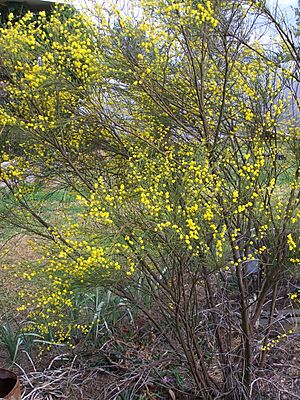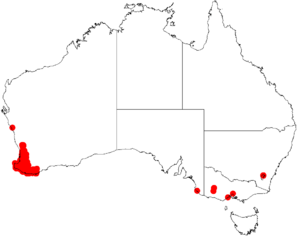Wiry wattle facts for kids
Acacia extensa, commonly known as the wiry wattle, is a cool shrub that grows mostly in the southwest part of Western Australia. It's special because it can fight off a plant disease called dieback.
Quick facts for kids Wiry wattle |
|
|---|---|
 |
|
| Scientific classification | |
| Genus: |
Acacia
|
| Species: |
extensa
|
 |
|
| Occurrence data from AVH | |
| Synonyms | |
|
|
Contents
What the Wiry Wattle Looks Like
The wiry wattle is an evergreen shrub, which means it stays green all year round. It can grow up to 2 metres (7 ft) tall. If people grow it in their gardens, it might even get taller!
This bush sometimes has branches that hang down a bit. Its branches are green and have yellowish lines, and they are glabrous, meaning they are smooth and don't have any hairs.
Leaves and Flowers
The leaves of the wiry wattle are light green and look like thin threads. They are called phyllodes and are scattered along the branches, looking a lot like the branches themselves. These phyllodes can be quite long, from 6 centimetres (2.4 in) to 24 centimetres (9 in) in length, but they are very thin, only about 0.75 millimetres (0.03 in) to 2 millimetres (0.08 in) wide.
Acacia extensa usually blooms in spring, between August and October. It produces pretty yellow flowers that are shaped like small balls. These flower balls are usually less than 1 centimetre (0.39 in) across. They grow on short stems called racemes.
How the Wiry Wattle Got its Name
The wiry wattle was first officially described by a botanist named John Lindley in 1839. He wrote about it in his book called A Sketch of the Vegetation of the Swan River Colony.
Over time, other botanists gave it different names, but these are now considered synonyms (other names for the same plant). Some of these names were Acacia graminea by Johann Georg Christian Lehmann, Acacia pentaedra by Eduard August von Regel, Acacia calamistrata by Nikolaus Joseph von Jacquin, and Racosperma extensum by Leslie Pedley.
The very first sample of this plant, called the type specimen, was collected in the Swan River Colony by a botanist named James Drummond. This sample helps scientists know exactly which plant is being described.
Where the Wiry Wattle Grows
You can find Acacia extensa in the southwest part of Western Australia. It grows as far east as Albany and as far north as Leeman.
This plant likes to grow in sandy soils or sandy soils mixed with laterite (a type of reddish soil). It especially likes damp places, such as along rivers or streams, or near lakes and swamps.

